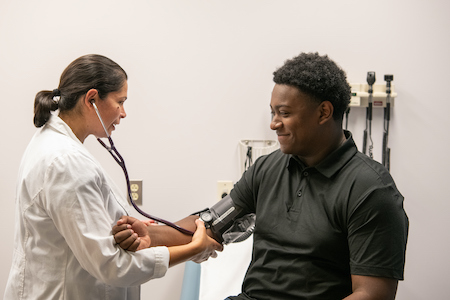Don’t Forget the Teens
February 07, 2022 Giordana Segneri
Adult-gerontology primary care nurse practitioners are critical to adolescent health.
What’s in a name? Not everything, especially when it comes to adult-gerontology primary care nurse practitioners (NPs). Yes, they care for adult and for gerontological populations, but they care for adolescents, too, and the fact that they care for patients as young as 13 often is overlooked or not clearly understood. The importance of these NPs to teen health is a message that UMSON’s Doctor of Nursing Practice (DNP) program is working hard to communicate.
The DNP Adult-Gerontology Primary Care Nurse Practitioner (AGPCNP) specialty is focused on providing care to individuals from age 13 through the end of life. These providers work in a variety of settings, including primary care offices, internal medicine, corrections facilities, urgent care centers, school-based wellness centers (SBWCs), pain management clinics, hospice/palliative care facilities, assisted living settings, chronic rehabilitation/long-term care centers, and more.
“By working with teens, young adults, middle-aged people, and geriatric patients, AGPCNPs influence health outcomes and improve the quality of life for their clients and family members,” says Molly Parsons, EdD, MS, FNP-BC, assistant professor, who has worked in a variety of settings to educate and promote healthy behaviors among adolescent patients. Her past clinical settings include SBWCs, sexually transmitted infection/family planning clinics, and urgent care centers.
Adolescents* are nearly 42 million strong in the United States, composing 13% of the total population, according to 2019 U.S. Census Bureau data. Centers for Disease Control and Prevention (CDC) data from the same year show that more than one in five 12 - 17-year-olds are obese. It is critical to national health outcomes that this population is cared for by providers, such as AGPCNPs, who understand that their care must be distinct from that of children and of adults.
“Adolescents have unique needs based on their developmental stage,” Parsons explains. “Their minds and bodies are changing rapidly as they go through puberty, and this presents a great opportunity for health promotion and disease prevention among teens and young adults. These clients are exploring their identities, trying out new roles in life, and developing their personal independence. They are also being exposed to many new things as they grow and mature into young adults, and these experiences present some potential for health risks. AGPCNPs are well prepared to educate teens about their minds and bodies, to promote healthy behaviors, and to help them make decisions to minimize risk and prevent disease.”
For advanced practice nurses who may not want to treat a pediatric population but also do not necessarily want to focus on the elderly, the AGPCNP specialty allows them to care for a population that has a great need for trustworthy, respectful providers, especially as adolescents mature and learn more about their bodies and their health.
“AGPCNPs share relationships with their patients built on trust and current evidence regarding health care,” Parsons explains. “They have knowledge about normal adolescent growth and development stages. Using this knowledge, AGPCNPs are well prepared to capitalize on the teens’ quest for independence and support the development of sound decision-making skills.”
Now, these providers are working hard to educate adolescents about the importance of vaccinations; on Jan. 5, the CDC approved boosters of the Pfizer/BioNTech COVID-19 vaccine for those 12 and older, and empowering this population to educate itself is critical to the nation’s population health outcomes. “AGPCNPs can show teens how and where to look for accurate, evidence-based health information,” Parsons says. “This allows teens to utilize their technological skills but, at the same time, helps to ensure they are receiving accurate information about vaccine recommendations.”
* U.S. Census Bureau defines adolescents as 10 - 19 years old.